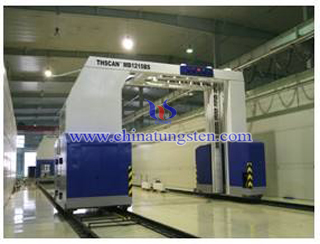Tungsten Alloy Used in Large Container Inspection System
- Details
- Category: Tungsten Information
- Published on Friday, 11 August 2017 15:46
Large container inspection system is one of the most urgent testing facilities in the customs port. At present, the inspection of containerized cargo mainly adopts the method of unpacking inspection or radiation imaging. Unpacking needs long time and high cost.
For radiation imaging, large container inspection system with accelerator or cobalt -60 as radiation source has been developed at home and abroad. Since cobalt -60 is an artificial radioactive isotope, a beta decay nuclide that emits beta and gamma rays, which has extremely strong radioactivity, tungsten alloy shields are used in large container inspection system to shield the radiation source.

Radiation resistance is related to the density of shielding materials. The higher the density is, the better the shielding performance is. As tungsten alloy has high density and atomic number, it has many advantages to be radiation shielding material, such as high ray absorbing ability, excellent weldability and workability. Its excellent comprehensive performance makes it has become the best choice for large container inspection equipment of the radiation shielding.
Imported and exported goods are becoming more and more abundant, forming the transshipment centers of steel, coal, waste paper, pulp, timber and stone, which need more and more requirements of radioactivity inspection. The large container inspection system using cobalt -6 as a radiation source belongs to large-scale radioactive detection system. It has been popularized in China's large ports in recent years. This kind of instrument consists of large capacity plastic scintillator and signal detection analysis system, which carries out real-time monitoring of radioactive substances such as containers, large vehicles, luggage, etc to achieve the functions of abnormal radioactive isotope entrainment and real-time linkage and early warning. Artificial nuclide recognition technology based on feature spectrum distribution, dynamic scanning and discrimination can effectively reduce the rate of knowledge discovery and missing reporting. Because of the large size of the detector and continuous scanning, it greatly improves the speed of inspection, quarantine and customs clearance.
| Tungsten Alloy Supplier: Chinatungsten Online www.tungsten-alloy.com | Tel.: 86 592 5129696; Fax: 86 592 5129797;Email:sales@chinatungsten.com |
| Tungsten News & Prices, 3G Version: http://3g.chinatungsten.com | Molybdenum News & Molybdenum Price: http://news.molybdenum.com.cn |